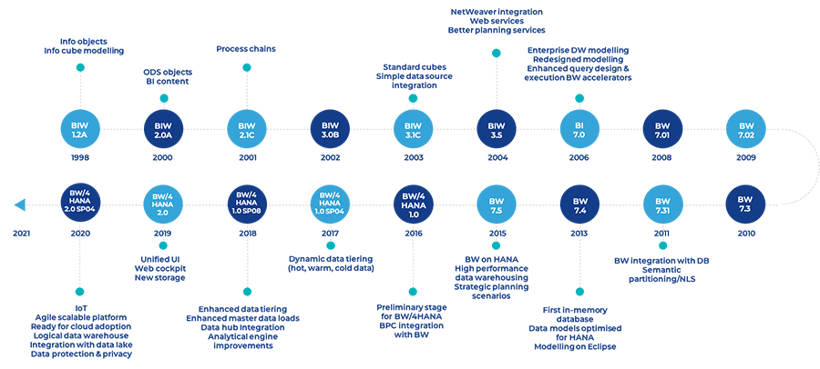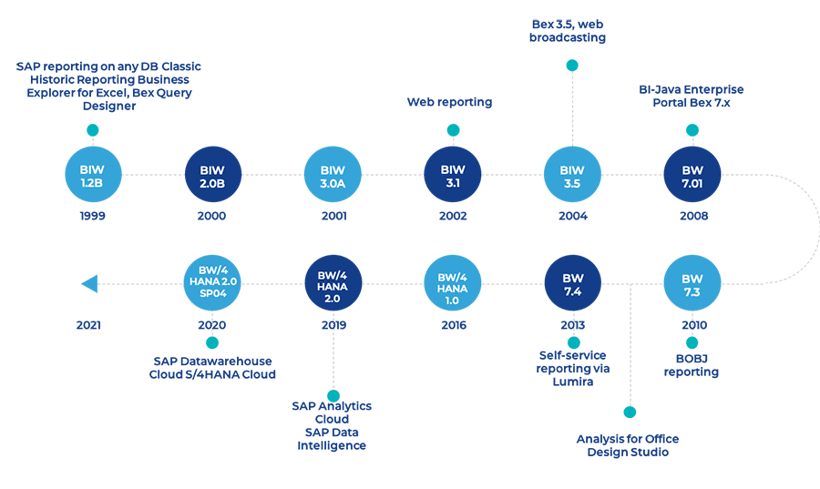Posted by:
Naveen Agarwal
Publish Date:
18 Feb, 2021
Effective data analytics has been a requirement for every organisation since the beginning of the industrial revolution, but the expectations around analytics have changed drastically. Before, it was about studying data and comparing it to older activity, but now organisations want more.
To dominate the market, or to make a presence felt, is based on how well an organisation can extract, understand and translate its insights. With increasing data sources within the business and across external sources - competitor data, social media feeds, internet enabled devices - it’s crucial to access smarter and more accurate information. Due to a scaling ecosystem, agile business needs and increasing user demands, organisations are finding they need more effective tools and strategies.
Over the past two decades, providers like SAP, who offer advanced platforms, have had a drastic change in the vision for modern analytical solutions. SAP has played an important role here and pursued constant evolution in two crucial areas of data analytics - data warehousing and front-end reporting.
Data warehousing
Organisations deal with huge data volumes and constantly changing user demands, while trying to keep their platforms simple and scalable. Businesses increasingly want to consolidate their systems and sources into a platform to meet needs and add more business value.
Over the years, SAP Business Warehouse (BW) has kept up with these changes with a stable platform inclusive of the extraction, modelling and reporting all within the platform. SAP BW has grown and embraced SAP HANA both as a database and as a platform, providing value to customers as well as showcasing its capabilities. Here’s a snapshot of how SAP has evolved its data warehousing capabilities over time:

Figure 1: Evolution of SAP’s data warehousing capabilities
The key benefits of effective data warehousing include:
- Enhanced business intelligence
- Enhanced data quality and consistency
- Better-informed decision-making process
- Streamlined information via enhanced data integration
- A single source of truth
- Key prediction and planning scenarios
- Optimised performance
- Wider ecosystem integration (social media, big data, third party sources)
Front-end reporting
In addition to an agile data warehouse, organisations also need unified and simpler reporting tools, so they can build and consume business intelligence with ease. Instead of spending time on reporting, using tools and software enables businesses to automate and present the data visually and with ease.
As business needs evolved, so did the scale of reporting and interactivity. This means the way users interact with reports has changed. What used to be simple visualisations of data is now more focused on data discovery, predictive analytics and planning insights, using artificial intelligence (AI) and machine learning (ML) models. The ability to dissect data is now being moved from data scientists and analysts to non-technical decision makers. With this, making more objective, data-driven decisions is becoming easier.
SAP’s focus in this area has developed drastically over the last few decades. Here’s an example of how the provider has evolved its front-end reporting tools over the years:

Figure 2: Evolution of SAP’s front-end reporting tools
Conclusion
There’s been an explosion of analytics platforms and tools, trying to capture the needs of business users. With the introduction of cheaper components, machine learning and predictive analytics are within reach of the average business user. Due to this, the game of consolidation has emerged in full force in recent years and today, business analytics is commonplace, adopted broadly across industries, organisations and geographies.
Needless to say, data analytics has come a long way and is now key to business success. Organisations can apply analytics and tools to extract meaningful trends and insights that quickly deliver valuable intelligence, agile visualisations and advanced predictive analytics — on any device or platform at any time.